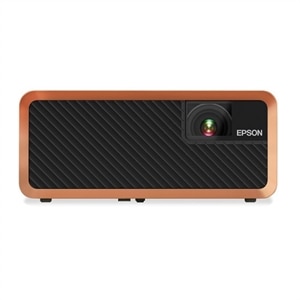Enter password on Home Screen if one has been set.
Press the on/off button on the side of theprojector and wait for it to power on.Press power button.Once on the home screen, go back to Menu and select Settings > Projector Setup >Output Settings (or similar)Choose desired resolution such as 1080p or 720p (these settings will vary depending on individual projectors)Make sure "Display" is set to On and check cables if necessary.Turn on the projector.Adjust brightness/contrast, if necessary using the button or remote.At this point we can also turn on the built-in speakers and audio system.NOTE: you may want to close any doors/windows leading to the room where you are sitting to prevent noise from reaching the projector screen.Now that your projectors ready, make sure you follow these instructions carefully and do not skip stepsThis is what the steps are supposed to look like when done correctlyA very useful feature is Remote Control which allows you to change settings via free remote application for Android or iOS devices.
Image source: https://www.dell.com/
Main competitor to Epson is Optoma with their Pico line of projectorsSony, BenQ, Eagle Optics and Epson have manufacturing plants in China. Dell Manufacturing has a manufacturing facility in China.More information about the Chinese companies working with Epson can be obtained on the Projector Manufacturers Association (PMAA) website which can be found at www.projector-maa.orgWhile Epson projectors are usually well built, some reviews have reported issues with light leaks in the projector and have suggested that the warranty be used to protect against this issueEpson's free support forum is at www.epsonforums.com.Epson has launched a variety of printers at different price points, ranging from very affordable all the way up to high cost color models exceeding $10,000USD or £8000GBP. The current line-up is shown below:How to Turn on an Epson Projector
Image source: https://www.amazon.com/
1. Make sure you have the projector set up. Make sure your computer is connected to the projector, if not, plug it in. Push the button on the rear of the projector to turn it on.
2. Press Menu or Select on your remote control or keyboard. Select “Input Source” and select HDMI #1 or #2 depending where you plugged your computer into (these are typically labeled). If you do not see them listed, try pressing Display Outputs and then pressing Update Display List - this should update your list to include anything plugged into ports 1-3 (computer). If that doesn't work, you might need to reset the projector (see below).
3. Select your video connection now. The projector may tell you it's connecting to the computer, but try again a few seconds later. This is normal and means there is an issue with your computer or connection. You won't have access to your computer until this is resolved, so keep trying and don't worry about the time.
4. Once your computer is connected to the projector, you should be able to see the image on the screen clearly. If you do not see it or it's fuzzy or grainy, you need to adjust the focus control on the front of your projector. It's a small knob and has a white triangle with two arrows that normally face outward- rotate this knob in either direction until you can see an image clearly.
5. If you cannot connect to the projector using HDMI or DisplayPort, try resetting your projector 4 different ways:
Method 1: Press Star * 9 + Power at same time on remote - go back into menu and recharge battery if prompted.


Comments
Post a Comment